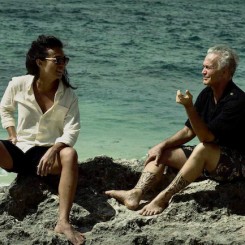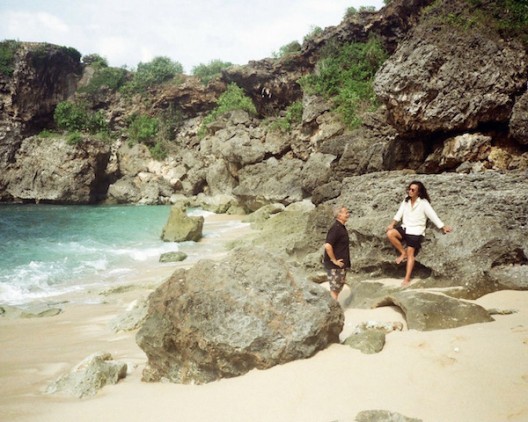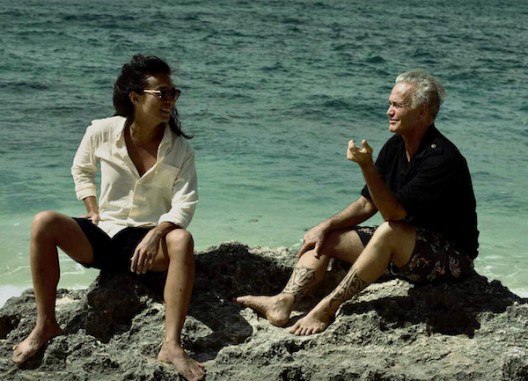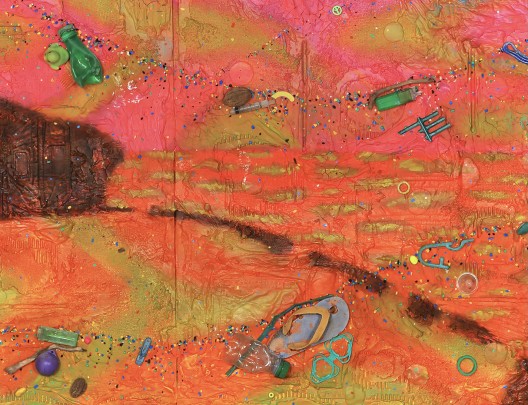Seascapes At The End Of History
by Adi Hong-Tan
“I suppose it’s like porno”, the artist Ashley Bickerton chuckles at that day’s handful of surfers, mostly novices of middling ability; “you’d rather not watch somebody who can’t perform.” We are having a solitary walk at Balangan beach in late July 2020. It is the middle of our summer lockdown in Bali, part of the Indonesian island’s effort to stem the surge of Covid-19. “I’ve surfed here for 30 years,” declares Bickerton, “sometimes on its biggest days ever…but, also, on the smallest days because I love to ride long boards.” My interlocutor is showing me around the coastal strip he considers his home turf.
Born in Barbados in 1959, Ashley Bickerton had a peripatetic childhood across four continents, from Guyana to Ghana, on to the Balearic Islands and England, then finally Hawaii. His upbringing followed the career of his Anglo-American father, the eminent linguist Derek Bickerton, who researched creole languages and theorised on the formation of human language. The younger Bickerton admitted that his father’s work gave him a sense of “the amorphousness of language”. On one hand, he says, “nothing exists without being named”, while on the other “there’s a slipperiness to all meaning…Wording is about things trying to be held down and pinned which are always in a state of flux.” Much of this thinking colours his life and work. While there is a firm conceptual agnosticism in his art, there is also a recognition of the impulse to name: our attempt, artificial though it be, at creating meaning.
Bickerton completed his studies in 1982 at the California Institute of the Arts, then moved to New York to take part in the Whitney Independent Study Program. He shot up to prominence as part of the so-called ‘Fab Four’, a group consisting of Jeff Koons, Peter Halley, and Meyer Vaisman. Their show at Sonnabend Gallery, in 1985, was hailed by many as the beginning of the Neo-Geo movement. The art critic Roberta Smith, reviewing the show in the New York Times, suggests it heralds “the return of an art that is certifiably American and firmly rooted in the Pop-Minimal-Conceptual tradition. It clearly replaces Neo-Expressionist excess with cool calculation…[and] a bumptious, youthful aggressiveness.”
When applied to him, however, Bickerton has always thought the appellation ‘Neo-Geo’ misleading. He explains, “We were put together…[art dealer] Jeffrey Deitch invented that term.” For him, the unwelcome tag reflects neither his creative vocabulary then, nor his immediate personal affiliations. Conceptually, only Halley was truly Neo-Geo in his exploration of geometric forms and structures. The moniker, moreover, fails to represent Bickerton’s circle at the time accurately: “I was actually much closer to a lot of younger artists because I, myself, was younger, but I’d gotten stuck with the Sonnabend grouping.” A plethora of other labels materialized to describe the supposed movement, from Simulationism to Neo-Conceptualism; from Post-Abstract Abstraction to Smart Art. Perhaps, the most descriptive of these terms in elucidating Bickerton’s early output is Commodity Art.
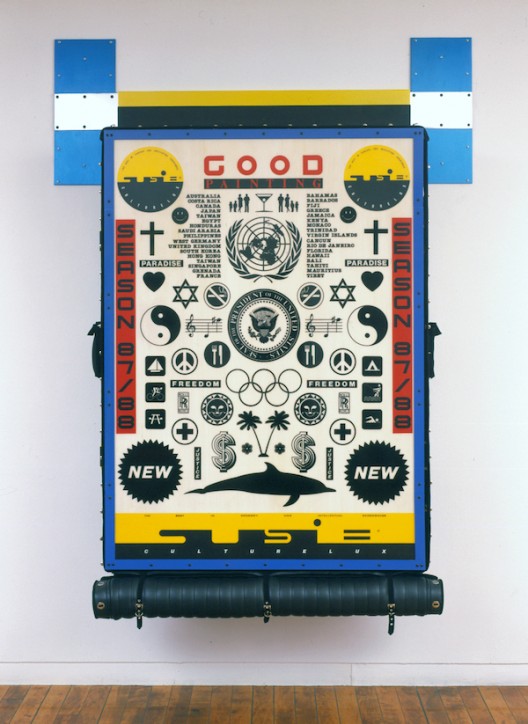
Ashley Bickerton
Good Painting (1988)
mixed media construction with neoprene covering
90 x 69 x 18 inches
228.6 x 175.3 x 45.7 cm
(image courtesy the artist)
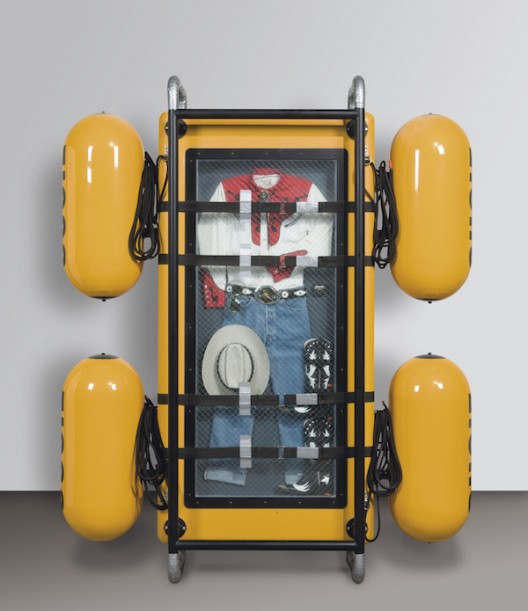
Ashley Bickerton
Seascape: Floating Costume to Drift for Eternity II (Cowboy Suit) (1992)
Cowboy suit, glass, aluminum, wood, caulk, fiberglass, enamel and canvas webbing
22 x 92 x 81 inches 55.9 x 233.7 x 205.7 cm
(image courtesy the artist)
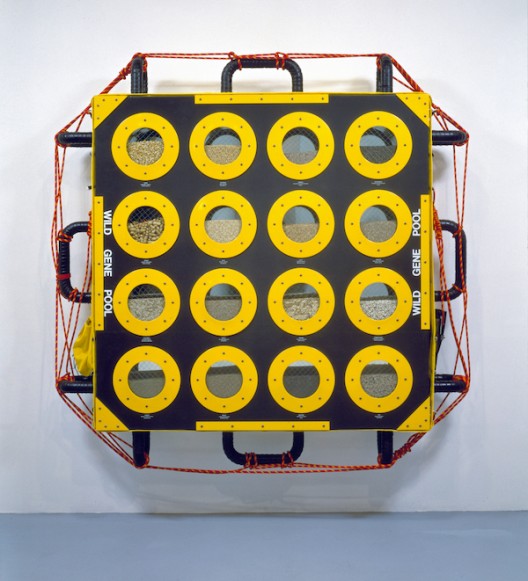
Ashley Bickerton
Wild Gene Pool: Ark # 2 (1989)
Wood, anodized aluminum, rubber, rope, leather and wild seed
76 x 76 x 121⁄2 inches
193 x 193 x 31.8 cm
(image courtesy the artist)
His commodity-related works are often box-like pieces, strapped with buckles and brackets. Many of them are covered with an array of consumer logos and symbols, created painstakingly by hand, but so as to look mass-produced. In effect, these art objects are presented à la Warhol in a manner that recalls consumer goods. Among them are works branded ‘Susie’, which mimic how the trophies of ostentatious consumption are trademarked with luxury branding. Early Bickerton is an irreverent meditation on the interface between art, commodity culture and consumerism. It touches upon our impulse to name and valorise. Although the artist flirts with meanings, he seems happiest sitting on the fence, listening in on his crowd’s inferences and, maybe, laughing a little. In these different layers of communication, some might like to see cool irony or a witty tease; others may find a detached critique of consumer culture and capitalism. One intriguing layer is characterised by art historian Abigail Solomon-Godeau as being “the central role of fetishism or, alternatively, the insistence on the fetish character of the artwork”. The artist calls this his “iconisation” of consumer products, his way of investing a kind of apotheosis to the materialist spirituality of America.
As first proposed by Karl Marx, one might look at commodity fetishization as spirituality in a materialist, capitalist guise, perhaps with America as its heartland. If so, the unveiling of a commodity good could be seen as almost a sacred ritual in an otherwise mundane existence. Are such occasions America’s moments of high mystery? Bickerton implies so: “something arrives in a box, and you open it, and take it out, and before it’s put to use, before it becomes something utilitarian and gets scratched up or used, it’s just this perfect thing.” This unboxing – the unveiling – is something akin to the moment when, in a Hindu temple, the doors of the Holy of Holies are flung open to reveal the idol within. Any kind of fetishization demands the suspension of reason and the projection of meaning onto an object. Any act of naming calls for a momentary pause, however temporary, in the unceasing flux of meanings around us. At the same time, all theories aside, there is a visceral, childlike joy in actually suspending thought and time: in distilling a moment of perfection in even the most humdrum of manufactured commodities – fetish pleasure, perhaps, but not without a quality of spirituality. Bickerton’s commodity art pokes fun at the artificial nature of cultural production, all the while illuminating the very human impulse to name and create meanings.
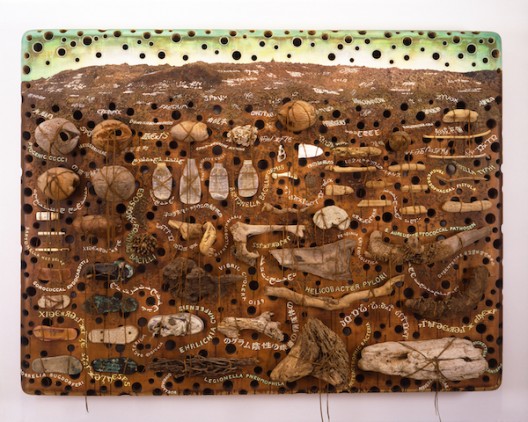
Ashley Bickerton
Landscape With Green Sky (2002)
Photo collage, acrylic and objects on wood 72 x 96 x 14.5 inches
182.9 x 243.8 x 36.8 cm
(image courtesy the artist)
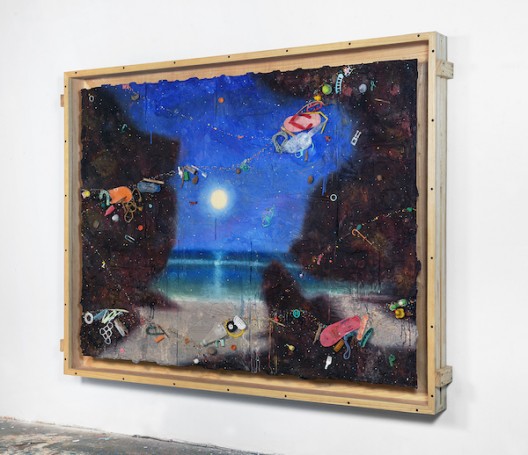
Ashley Bickerton LARGE
Open Flotsam Painting
171.5cm x 227cm x 14.7cm
67 1/2″ x 89 3/8″ x 5 3/4″
(image courtesy the artist)
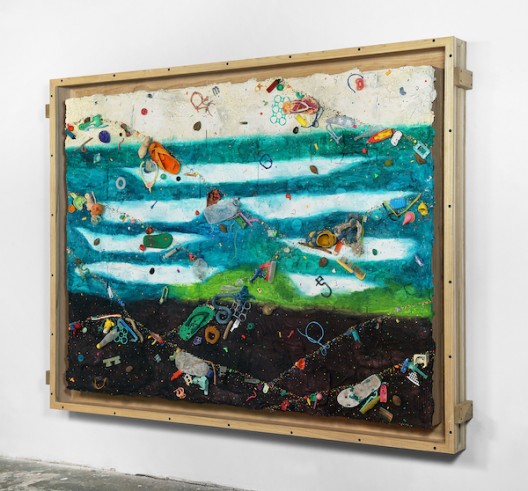
Ashley Bickerton
Green Waves (2020)
flotsam, ocean borne detritus, oil paint, acrylic paint & rocks on wood and cardboard
171.5cm x 227cm x 14.7cm
67 1/2″ x 89 3/8″ x 5 3/4″
(image courtesy the artist)
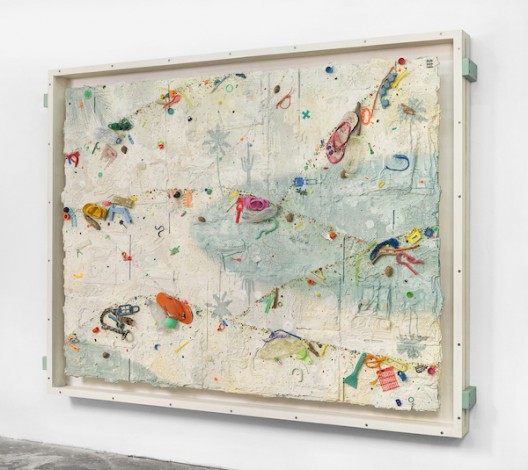
Ashley Bickerton
Dawn Estuary (2020)
flotsam, ocean borne detritus, oil paint, acrylic paint & rocks on wood and cardboard
171.5cm x 227cm x 14.7cm
67 1/2″ x 89 3/8″ x 5 3/4″
(image courtesy the artist)
Unless seen as a cultural critique, the artist’s move to Bali in 1993 seems to be a world away from this discussion. By then, he had become increasingly disenchanted with the fashions and politics of New York’s art world or, in his own words, its “different degrees of fawning”. Moreover, as an artist, he was no longer in vogue. Bickerton could probably have worked his way back into the good graces of the fickle market. After all, he had been offered the enviable platform of a full-time teaching position at Harvard University which, to the chagrin of his academic parents, he ended up turning down. He reasons: “I was always a surfer; and I’d given it up to pursue art. So, I just figured, screw that! I’m not going to hang out here.” As a matter of fact, having grown up and lived by the sea for most of his life, his twelve years in New York were something of a wintry, geographic aberration. Now, a different vision of life beckoned. He envisioned more familiar, tropical surroundings – a place far away from the din of New York’s art scene, where he could dedicate himself to his twin passions of art and surfing.
Thirty years on, we are wading through the island waters of his chosen home grounds. The Indonesian island of Bali, he clarifies, “is a huge part of the surfing world with some of the best waves anywhere.” Knee-deep in the sea, he is leading me along a rocky promontory, just off Balangan beach. Banyan-covered limestone cliffs rise up above us until we end up in a grotto, overlooking the Indian ocean. Here, the artist married his fourth and current wife, Cherry, a bright, young Balinese eco-entrepreneur. “It’s my temple,” he professes, “a point of alignment.” From surfing mecca to the wedded contentment of home life, the deep connection he feels to the sea here is palpable: “I don’t really believe in too much outside of the realms…of empirical reality, but right after we got married…while trying to paddle out to surf on a big day, a wave washed my feet out from underneath me, and then I hit the reef and tried holding on as the wave washed me back. It tore both my wedding and engagement rings clean off!”
The conventional reading of Bickerton’s career sees his expatriation as a profound change of direction in his conceptual trajectory. The art critic Calvin Tomkins, writing in the New Yorker in 2007, goes so far as to claim that Bickerton “dropped out of the art world”. A succession of clichés come to mind, of escapism, of his supposed life as a privileged, expatriate artist on a tropical island paradise, in short of a latter-day Gaugin. In a similar vein, but with an attempt at empathy, the writer Paul Theroux speaks of Bickerton as “a connoisseur of not belonging”. For Theroux, expatriates like himself and Bickerton, “travel from culture to culture…from one preposterous belief system to another, always teetering just outside it. The challenge of their quest, and their entanglement, is how to represent this profusion of images and beliefs…and more than that, the mass of tactile sensations and smells…the world as wreckage” – both victors and victims of rootless globalisation.
On the surface, the visual vocabulary of Bickerton’s works in Bali certainly departed from their commodity art antecedents. There was a notable shift towards figuration with extravagant, salacious references to Gauginesque life on an island-paradise. At one level, it is the artist’s playful response to other people’s acts of naming, of him as Gaugin-like, of migration as escapism. He himself looks with disdain at exoticism qua exoticism. For him, most of its practitioners “have airs and aspirations that go beyond…the parameters of their actual accomplishments.” Anything bucolic or decadent in his rendering of tropical life invariably serves a purpose: asking probing questions, but with a firm, resolute agnosticism as to their possible answers. During this period, the recurring, grotesque figure of the Blue Man emerged. He is a macabre personification – sometimes an exaggerated self-parody – of much that one finds confronting in contemporary Bali: from the white, male gaze upon Asian femininity, to so-called Orientalist othering, besides the excruciating cultural and environmental effects of crass, mass tourism.
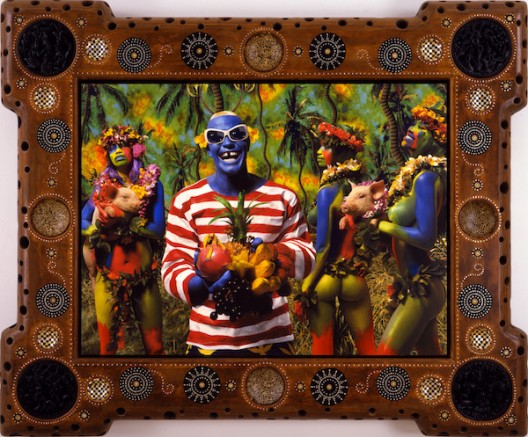
Ashley Bickerton
The Preparation With Green Sky (2007)
Acrylic and digital print on canvas in carved wood, coconut, mother of pearl and coin inlaid artist name
72 x 86 x 7 inches
182.9 x 218.4 x 17.8 cm
(image courtesy the artist)
As pointed out by Solomon-Godeau, these references to “forms of exoticism…possess neither more nor less authenticity or authority than do the corporate logos with which Bickerton earlier adorned his works.” In other words, the artist in Bali quotes from a more comprehensive dictionary of world cultures, but in “the same postmodern syntax that informed the so-called Neo-Geo production of the 80s”. Solomon-Godeau further suggests that Bickerton’s “shift to figuration in no way diminishes his preoccupation with the protean forms of fetishism, in either its commodity or its psychic manifestation (or both).” He humorously drew a parallel between ‘human being’ and ‘commodity’, then proceeded to play with the naming and fetishization of both. Viewed thus, there are persistent, conceptual commonalities between his oeuvres in New York and Bali. His move to Bali merely enlarged the scope of his references, moving beyond the East Village art scene to an ancient culture in the throes of globalisation and modernity – a rapidly urbanising island of five million, rich in the many permutations of contemporary tropical life. Through it all runs an abiding fascination with the ambiguity of cultural production. This extends, perhaps, to his treatment of the reductive reading of his move to Bali as Orientalist escapism tout court.
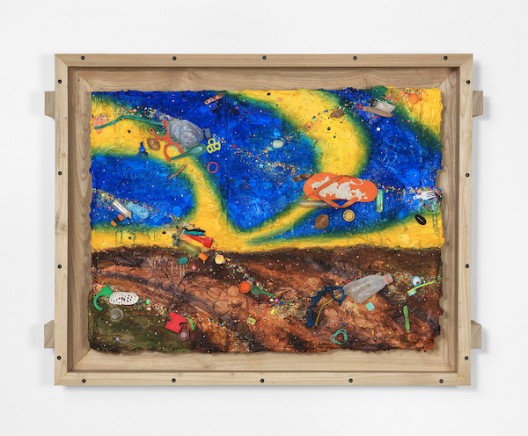
Ashley Bickerton
Night Sky Over Fallow Field (2020)
flotsam, ocean borne detritus, oil paint, acrylic paint & rocks on wood and cardboard
95cm x 126cm x 14.7cm
37 3/8″ x 9 1/2″ x 5 3/4″
(image courtesy the artist)
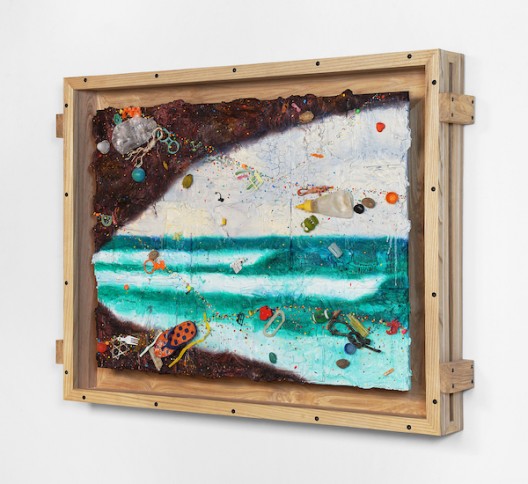
Ashley Bickerton
Balangan Cave (2020)
flotsam, ocean borne detritus, oil paint, acrylic paint & rocks on wood and cardboard
95cm x 126cm x 14.7cm
37 3/8″ x 9 1/2″ x 5 3/4″
(image courtesy the artist)
All too aware of appearing the Orientalist escapist, Bickerton initially removed Bali from his creative identity here. His first studio on the island was a plain, nondescript space that could have existed anywhere in the world. Today, however, he is probably the first to acknowledge that over the decades, through the tiniest cracks and crevices, “the seams in closed windows”, despite his own initial misgivings, ideas from Bali, maybe even Indonesia at large, have seeped in. The most obvious local influences, such as the elaborate carvings on his frames or the conflicted references to expatriate life, are identified aptly by Solomon-Godeau as “citations” with “implied quotation marks”. Other, equally fascinating echoes of Bali and Indonesia suffuse the artist’s output. To start with, his low opinion of most expatriate art – unconsciously or not – mirrors the inaugural position of his adopted country’s postcolonial modern art. This was asserted by one of its leading masters and pre-eminent theorist, S. Sudjojono. As early as 1939, Sudjojono dismissed what he judged to be languorous, overly romanticised representations of colonial Indonesia as the ‘tourist art’ of the ‘Mooie Indië’ [Beautiful Indies]. Unwittingly, Bickerton began his career in Southeast Asia with a mind-set not too dissimilar from the foundational premise of modern art practice in Indonesia.
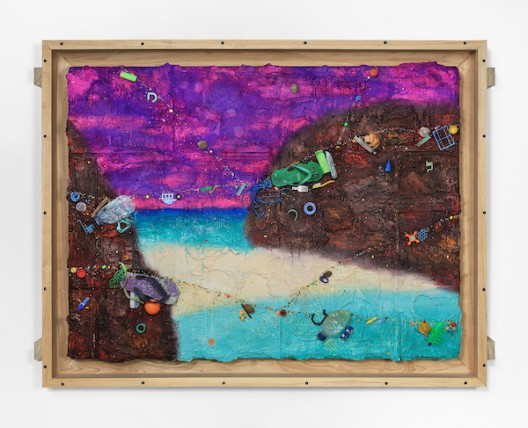
Ashley Bickerton
Lagoon With Storm Front (2020)
flotsam, ocean borne detritus, oil paint, acrylic paint & rocks on wood and cardboard
133cm x 176cm x 14.7cm
52 3/8″ x 69 1/2″ x 5 3/4″
(image courtesy the artist)
For me, though, the most thought-provoking echoes of Indonesia in the artist’s body of work are in its unfolding dialogue with the art and artists of Bali. Similar to the typical layout in Bali’s Batuan school of painting, Bickerton’s creations are often crowded to the brim with characters, objects and events – the world as a bustling, maddening mandala-marketplace of commerce and spirituality, of quotidian nightmare and dreamlike reality. An admirer of Batuan style, Bickerton appreciates how it “brought the traditional formal spaces into their own form of modernity.” He confesses: “that earth and sky binary I’ve got in my paintings definitely comes from looking at both Surrealism, like Miro, even Dali, with their mass and emptiness represented by brown and blue, but also at Batuan, where grey-greeny browns and green-browny greys give it its tone.” Batuan artists reconfigured ancient spaces as a contemporary universe. Here, modern life, pulsating with energy, confronts sinister demons, both old and new, among whom the Blue Man himself would not be out of place.
There are also traces in Bickerton of the singular master from Ubud, I Gusti Nyoman Lempad. Over the course of a long life and career from the late nineteenth century until his death in 1978, Lempad produced a canon of powerful, psychologically prescient, figurative drawings and sculptures. “His understanding of human sexuality”, notes Bickerton, was “so ahead of his time, so liberating, so complex, and with a gorgeousness of line and warmth.” In Red Scooter Nocturne, the Blue Man plonks himself with unseemly heft, flabs overflowing, on his tiny scooter, while the elongated, twirling, silver-skinned, snake-like females of Temptation in the Banjar, gyrate and hiss. The sensibility and line of their movements recall those of Lempad’s characters. In the output of both artists, there is a similar sense of humour, resigned but smirking at the world’s many contradictions.
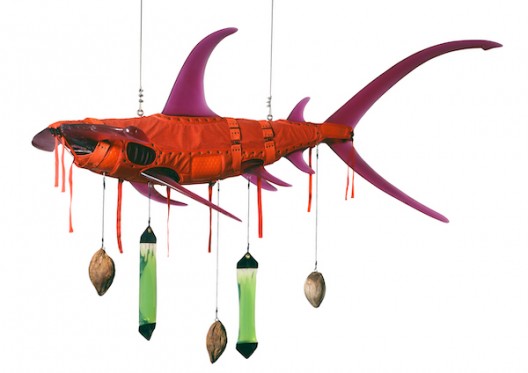
Ashley Bickerton
Orange Shark (2008)
Polyurethane resin, nylon, cotton webbing, stainless steel, scope, distilled water, coconuts, rope
60 x 108 x 60 inches
152.4 x 274.3 x 152.4 cm
Edition of 3
(image courtesy the artist)
The contradictions in Bickerton’s art, with its underlying conceptual agnosticism, sit comfortably with Bali’s hybridised metaphysics. The artist reflected in a recent interview: “It’s not that I want to define what is dark and what isn’t. I simply think that we must acknowledge that it all exists and get off it”. Here, there are shades of the Balinese worldview. Part-Hindu, part-Buddhist, part-animist, it makes no unequivocal pontifications on either good or bad, sacred or profane. Unlike Abrahamic systems of belief, Balinese spirituality considers ambiguity as part of the natural order. There are, then, tantalizing echoes of Bali and Indonesia in Bickerton’s works. To me, the insistence on seeing him as a latter-day Gaugin is untenable in light of both the nature of his interaction with his adopted home and the conceptual commonalities in his entire corpus.
Rather than seeing Bickerton solely as a “white, male artist, living in the South Seas” – that is to say, through the perspectives of a politically correct, apparently metropolitan and mostly white American monoculture – it might be less parochial to regard him in an Indonesian context. To an Indonesian, the artist is a ‘totok’, or a first-generation migrant, behind whom ‘Peranakan’, or mixed-race, culture thrives. His Indonesian-born children encapsulate this process of creolisation: his youngest is a half-Balinese girl from his fourth and current marriage; and the older a half-Jakartan son from his third marriage. The latter comes on his mother’s side from a cultured and influential Peranakan family, founded in the last century by another totok, the pre-war, French intellectual Louis-Charles Damais and his aristocratic Javanese wife, R. A. Soejatoen Poespokoesoemo. There is a certain charm to the Peranakan identity of the younger Bickertons given Derek Bickerton’s study of creole languages and Ashley Bickerton’s upbringing among creole societies. The artist has found a home in a country where creolisation forms part of its national identity. Unlike America with its apparent multiculturalism of monocultures, forever weary of cultural misappropriation, Indonesia is defined by cultural hybridization. The very idea of Indonesia is a cultural and linguistic construct: etymologically, the country’s name is Greek from Ἰνδός [Indos] or Indian and νῆσος [nesos] or islands. For an artist so obsessed with the artifice of cultural production, it is fitting that he has ended up in a country that, according to historian Benedict Anderson, epitomizes the nation-state as an “imagined community”. Almost by accident, Bickerton has become a co-creator in this act of cultural production. It tells how an ancient society with a long history of civilizational, religious and ethnic hybridization, adapts to new forms of modernity.
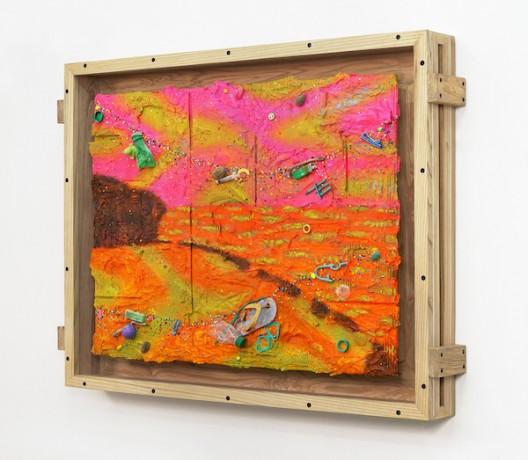
Ashley Bickerton
Balangan Sunset (2020)
flotsam, ocean borne detritus, oil paint, acrylic paint & rocks on wood and cardboard
95cm x 126cm x 14.7cm
37 3/8″ x 9 1/2″ x 5 3/4″
(image courtesy the artist)
From this vantage point, a lot of Bickerton’s art elicits conversations about the varied forms that this much-mentioned cultural production might take. “Culturescapes are fun,” he avows, “but ultimately too hectic and too noisy. I long for great silence and great emptiness.” In keeping with this meditative turn, as noted by writer Anthony Haden-Guest, the artist’s current practice is “now undergoing further development, and a striking one”. I notice this, too, at his studio before we drive up to Balangan beach. His most recent creations have a quieter, contemplative quality to them, reminiscent of some of his earlier commodity pieces. The Flotsam Series are boxed-in, three-dimensional snapshots of simplified landscapes of sky-earth binary. These are overlain by whirling, circulating currents of sea-borne, man-made debris. For Bickerton, this all conjures up “borderless oceanic detritus, seascapes, culturescapes, swirling cosmologies of micro plastics, fragments of human narratives, residues of lives lived, of vestiges of human presence now swirling in great molecular vortexes.” These snapshots are fixed in a sky-earth setting that is almost sculptural, textured with thick layerings of cardboard, clothing and other miscellanea. Presented in his signature crates, the new works are in dialogue with the artist’s commodity creations – as if to commodify nature itself and transport it in containers on ships across the oceans. One might detect here, again, the fetishization of nature as commodity, or of commodity detritus as nature, or most likely both. “I’d ran away from certain parts of my past,” Bickerton owns up, “and I felt it was time to…circle back, embrace everything and move forward from there.”
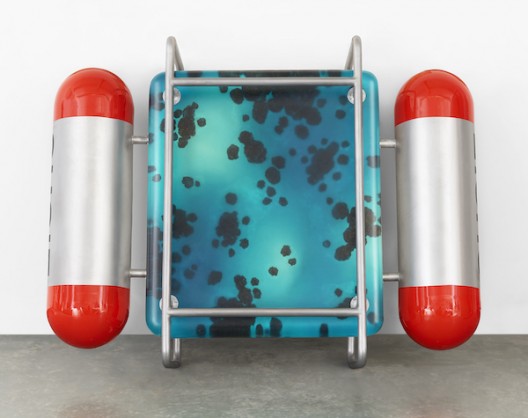
Ashley Bickerton
Seascape: Floating Ocean Chunk No. 1 (2017)
resin, fiberglass, oil paint, enamel, aluminum & plywood
57 x 74 x 21 inches
144.8 x 188 x 53.3 cm
(courtesy the artist)
Standing with our feet in the sea, I comment that his Flotsam Series is topical given our preoccupation with plastic pollution, the pandemic, and man’s impact on nature. “Well, hold on,” the artist shoots back, “I’m not an environmentalist. Environmentalism labours under the presumption that we’re saving the planet for human habitation. We’re just one infinitesimal chapter in the enormity of the history of the biosphere; and the planet will eat us up and spit us out.” He explains: “I consider the great gyres of plastic in the Pacific as much a part of the natural order as the migration of wildebeests in the Serengeti. It’s the majesty of molecules…you’ve got great swirling vortexes of molecules as things wash and slush around the planet, and geological time moves on. And the blip of humanity’s imprint is wiped out. Gone!” Bickerton’s insistent agnosticism continues with his proffering that he is “just recording a moment and creating a dark kind of poetry. I don’t know what I’m doing it for. I don’t have much faith in what artists are…we’re perfumed, dancing poodles for the plutocracy. But the point is, if I can get into this place and inhabit that for a second, then I can forget that I’m a poodle. And I can get at a darker and deeper poetry.”
As we look at the horizon, I try recalling our earlier conversation, realising that the crashing waves will render our recorded interview inaudible, washed out – so to speak – in a puddle of salt water. I look at my bullet points: Neo-Geo, Post-Conceptual Conceptualism, Craig-Martin, Susie, Culture Lux, Koons, Gaugin, Mooie Indië’, primitivism, Spies, Batuan, Covarrubias, Lempad, postmodern, postcolonial, Peranakan. I think of the running thread in the artist’s canon, the ad-hoc artifice of cultural production, fetishism in its psychic and commodity forms; and of the quiet he longs for. Across the horizon now, with the sea-sky binary before us, I imagine whirling vortexes of seas, slowly gyrating round the planet as if in a Sufi dance, and in it, the remains of civilization: our flux of meanings, the artist’s wedding rings here, and bits of plastic there. This vision possesses a dark, trance-like kind of beauty. If you suspend time and thought, and inhabit that space for a second; then, before we turn to molecules and return to the swirling ocean, you might just hear Ashley Bickerton’s great silence.
Adi Hong-Tan is an Indonesian historian, writer and social activist, working in art and heritage conservation. He read Law at Christ’s College, Cambridge University, and now sits on the Committee and Advisory Board of Yayasan Mitra Museum Jakarta [Friends of Jakarta Museums Foundation].

